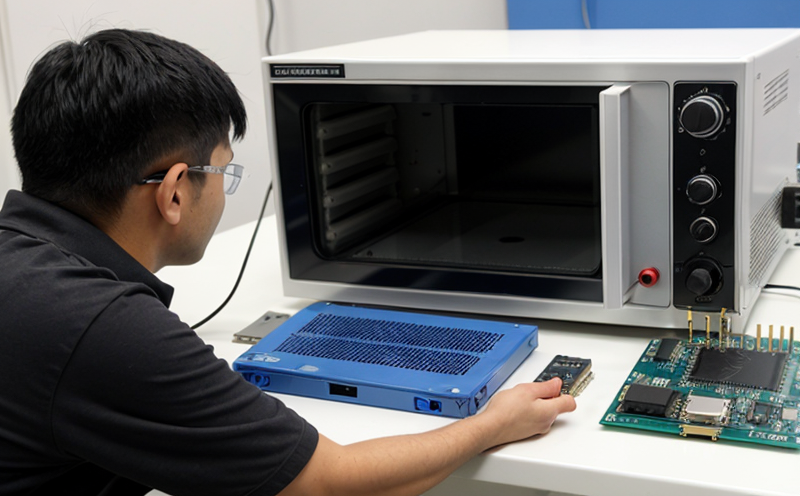EN 61000 EMC Testing for Microelectronic Systems
The European Standard EN 61000 is a series of standards that define the limits and requirements for Electromagnetic Compatibility (EMC) in electrical and electronic products. This standard aims to ensure that equipment functions as expected when deployed, without causing or being affected by electromagnetic interference.
Microelectronic systems are at the heart of modern electronics, from consumer devices like smartphones and computers to more complex systems such as medical equipment, industrial automation, and automotive electronics. Ensuring these systems meet EMC standards is critical for their reliable operation in real-world environments. This section will delve into how EN 61000 EMC Testing ensures that microelectronic systems are robust against electromagnetic interference.
EMC testing involves a series of procedures designed to evaluate the susceptibility and immunity of electronic devices or systems to external electromagnetic fields. The primary goal is to ensure that equipment does not disrupt other nearby electrical or electronic products, nor is it adversely affected by them. This testing covers both conducted emissions (CE) and radiated emissions (RE).
The standards outlined in EN 61000 are crucial for various reasons:
- They provide a benchmark for the performance of electronic products across different regions.
- They ensure that products can operate reliably in environments with varying levels of electromagnetic interference.
- They contribute to the overall safety and functionality of electrical systems, reducing the risk of accidents or malfunctions.
The testing process for microelectronic systems involves a range of procedures tailored to specific components and systems. These tests are conducted in controlled environments that simulate real-world conditions, ensuring that products perform as expected under various electromagnetic interference scenarios.
Microelectronic systems are particularly susceptible to electromagnetic interference due to their complex circuitry and high-frequency signals. Testing these systems requires specialized equipment and expertise to accurately assess their performance. The testing process typically includes:
- Initial Design Review: This involves an examination of the product's design plans to identify potential areas of concern related to EMC.
- Prototype Testing: Prototypes are tested under controlled conditions to identify any issues early in the development process.
- Production Line Testing: Once a prototype passes initial tests, production units undergo testing to ensure they meet the same standards as prototypes. This includes both laboratory and field testing.
The testing procedures are designed to be comprehensive, covering various aspects of EMC performance:
- Conducted Emissions: Testing for interference caused by signals conducted through wires or cables.
- Radiated Emissions: Testing for interference caused by electromagnetic radiation from the device itself.
- Susceptibility Testing: Evaluating how well a device can function in environments with high levels of electromagnetic interference.
The results of these tests are documented and reported, providing detailed insights into the performance of microelectronic systems. Compliance with EN 61000 standards ensures that products meet regulatory requirements and industry expectations, enhancing their marketability and reliability.
Why It Matters
The importance of EMC testing cannot be overstated in the realm of microelectronic systems. The global demand for electronic devices is continuously growing, leading to an increase in the complexity and interconnectedness of these systems. Ensuring that these systems meet EMC standards is essential for several reasons:
- Consumer Safety: Devices that do not comply with EMC standards can cause interference with other electronic products, potentially leading to malfunctions or even safety hazards.
- Product Reliability: Compliance with EMC standards enhances the reliability and performance of microelectronic systems in real-world environments.
- Market Access: Many countries have strict regulatory requirements for electronic products. Meeting these requirements is essential for product certification and market access.
- Brand Reputation: A reputation for producing high-quality, reliable products can significantly enhance brand image and customer trust.
Why Choose This Test
Selecting the appropriate EMC testing method is crucial for ensuring that microelectronic systems meet regulatory requirements and perform reliably in real-world environments. Here are several reasons why EN 61000 EMC Testing is an excellent choice:
- Global Recognition: The European Standard EN 61000 is widely recognized and accepted globally, ensuring consistent standards across different regions.
- Comprehensive Coverage: This testing method covers all aspects of EMC performance, providing a holistic view of the system's susceptibility to interference.
- Expertise and Experience: Our laboratory has extensive experience in conducting EMC tests for microelectronic systems, ensuring accurate and reliable results.
- Regulatory Compliance: Ensuring compliance with international standards is crucial for market access. EN 61000 EMC Testing helps meet these requirements effectively.
- Cost-Effectiveness: By identifying issues early in the development process, this testing method can save significant costs associated with rework or redesign.
Use Cases and Application Examples
The applications of EN 61000 EMC Testing for microelectronic systems are vast, spanning multiple industries. Here are some examples:
- Consumer Electronics: Products like smartphones, tablets, and laptops require rigorous testing to ensure they function reliably without interfering with other devices.
- Automotive Electronics: Cars today contain an increasing number of electronic components. Testing ensures that these systems operate safely and efficiently in challenging environments.
- Medical Equipment: Medical devices such as pacemakers and MRI machines must be tested to ensure they do not cause interference with other medical equipment or patient safety.
- Industrial Automation: Complex industrial systems require reliable communication between components, making EMC testing essential for ensuring smooth operation.
In each of these use cases, the goal is to ensure that microelectronic systems perform consistently and safely in their intended environments. This testing not only enhances product reliability but also contributes to the overall safety and functionality of electronic devices.





